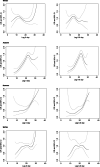Association between ambient temperature, particulate air pollution and emergency room visits for conjunctivitis
- PMID: 33627098
- PMCID: PMC7903634
- DOI: 10.1186/s12886-021-01854-1
Association between ambient temperature, particulate air pollution and emergency room visits for conjunctivitis
Abstract
Background: Numerous studies have confirmed the association of ambient temperature and air pollution with a higher risk of morbidities, yet few have addressed their effect on the ocular system. The purpose of this study was to assess the association between temperature, air pollution, and emergency room visits for conjunctivitis.
Methods: In this case-crossover study, the records of all emergency room visits to Soroka University Medical Center (SUMC) from 2009 to 2014 were reviewed for patients with conjunctivitis. Daily exposure to fine and coarse particulate matter and temperature were determined by a hybrid model involving satellite sensors. Mean relative humidity was obtained from the Ministry of Environmental Protection meteorological monitoring station located in Beer-Sheva.
Results: Six hundred one patients were diagnosed with conjunctivitis in the SUMC emergency room. We discovered a positive association between temperature increments and incidence of conjunctivitis. The strongest effect was found during summer and autumn, with an immediate (lag0) incidence increase of 8.1% for each 1 °C increase in temperature (OR = 1.088, 95%CI: 1.046-1.132) between 24 and 28 °C in the summer and 7.2% for each 1 °C increase in temperature (OR = 1.072, 95%CI: 1.036-1.108) between 13 and 23 °C in the autumn. There was no statistically significant association between fine and coarse particulate matter and conjunctivitis incidence.
Conclusion: Temperature increases during summer and autumn are significantly associated with an increased risk of conjunctivitis. Conjunctivitis is not associated with non-anthropogenic air pollution. These findings may help community clinics and hospital emergency rooms better predict conjunctivitis cases and will hopefully lead to improved prevention efforts that will lower the financial burden on both the individual and the public.
Keywords: Air pollution; Conjunctivitis; Ocular disease; Temperature; Weather.
Conflict of interest statement
The authors declare that they have no competing interests.
Figures


Similar articles
-
Air pollution and emergency department visits for conjunctivitis: A case-crossover study.Int J Occup Med Environ Health. 2016;29(3):381-93. doi: 10.13075/ijomeh.1896.00442. Int J Occup Med Environ Health. 2016. PMID: 26988878
-
Ambient air pollution, weather and daily emergency department visits for headache.Cephalalgia. 2015 Oct;35(12):1085-91. doi: 10.1177/0333102415570300. Epub 2015 Feb 4. Cephalalgia. 2015. PMID: 25653308
-
Acute exposure to fine particulate matter and cardiovascular hospital emergency room visits in Beijing, China.Environ Pollut. 2017 Jan;220(Pt A):317-327. doi: 10.1016/j.envpol.2016.09.065. Epub 2016 Sep 30. Environ Pollut. 2017. PMID: 27697383
-
Global Associations of Air Pollution and Conjunctivitis Diseases: A Systematic Review and Meta-Analysis.Int J Environ Res Public Health. 2019 Sep 28;16(19):3652. doi: 10.3390/ijerph16193652. Int J Environ Res Public Health. 2019. PMID: 31569424 Free PMC article.
-
Unraveling the conjunctivitis crisis: understanding the spiking incidence in Karachi and Lahore-Pakistan.Ann Med Surg (Lond). 2023 Dec 13;86(2):920-922. doi: 10.1097/MS9.0000000000001623. eCollection 2024 Feb. Ann Med Surg (Lond). 2023. PMID: 38333251 Free PMC article. Review.
Cited by
-
TFOS lifestyle: Impact of societal challenges on the ocular surface.Ocul Surf. 2023 Apr;28:165-199. doi: 10.1016/j.jtos.2023.04.006. Epub 2023 Apr 14. Ocul Surf. 2023. PMID: 37062429 Free PMC article.
-
Epidemiology and tumor microenvironment of ocular surface and orbital tumors on growth and malignant transformation.Front Oncol. 2024 Oct 3;14:1388156. doi: 10.3389/fonc.2024.1388156. eCollection 2024. Front Oncol. 2024. PMID: 39421442 Free PMC article. Review.
-
Impact of particulate matter and air pollution on ocular surface disease: A systematic review of preclinical and clinical evidence.Ocul Surf. 2025 Jan;35:100-116. doi: 10.1016/j.jtos.2024.12.003. Epub 2024 Dec 12. Ocul Surf. 2025. PMID: 39672270
-
Nonlinear effects of humidex on risk of outpatient visit for allergic conjunctivitis among children and adolescents in Shanghai, China: A time series analysis.J Glob Health. 2023 Nov 3;13:04132. doi: 10.7189/jogh.13.04132. J Glob Health. 2023. PMID: 37921044 Free PMC article.
References
-
- Aditi B, Jan W, Alina V, Nicholas H, Joacim R, Shakoor H, Rainer S. Effects of air temperature on climate-sensitive mortality and morbidity outcomes in the elderly; a systematic review and meta-analysis of epidemiological evidence. EBioMedicine. 2016;6:258–268. doi: 10.1016/j.ebiom.2016.02.034. - DOI - PMC - PubMed
-
- Alpert P, Osetinsky I, Ziv B, Shafir H. A new seasons definition based on classified daily synoptic systems: An example for the eastern Mediterranean. Int J Climatol. 2004;24:1013–1021. doi: 10.1002/joc.1037. - DOI
MeSH terms
LinkOut - more resources
Full Text Sources
Other Literature Sources
Medical

